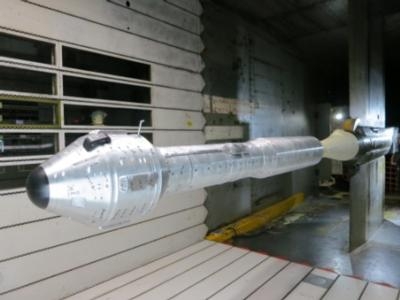Wed, Jun 05, 2013
Completes Wind Tunnel Testing Of CTS-100 Spacecraft, Atlas V Rocket
The Boeing Company of Houston, a NASA Commercial Crew Program (CCP) partner, recently performed wind tunnel testing of its CST-100 spacecraft and integrated launch vehicle, the United Launch Alliance (ULA) Atlas V rocket. The testing is part of NASA's Commercial Crew Integrated Capability (CCiCap) initiative, intended to make commercial human spaceflight services available for government and commercial customers.

Boeing and ULA also worked together to test a newly developed component of the Atlas V's Centaur upper stage. Boeing now has completed two of eight performance milestones under CCiCap and is on track to complete all 19 of its milestones around mid-2014. "The Centaur has a long and storied past of launching the agency's most successful spacecraft to other worlds," said Ed Mango, NASA's CCP manager at the agency's Kennedy Space Center in Florida. "Because it has never been used for human spaceflight before, these tests are critical to ensuring a smooth and safe performance for the crew members who will be riding atop the human-rated Atlas V."
The wind tunnel tests, which began in March and wrapped up in May at NASA's Ames Research Center in Moffett Field, CA, were the first interface tests of Boeing's spacecraft, launch vehicle adaptor and launch vehicle. A scale model of the integrated spacecraft and rocket was placed in Ames' 11-foot diameter transonic wind tunnel. The data gathered provides Boeing with critical information it needs to ensure its system is safe for launching crews to low-Earth orbit.
The Centaur liquid oxygen-feed duct line was tested in March in Murrieta, CA, to characterize how liquid oxygen moves from the stage's oxygen tank to its two engines where the propellant will be mixed with liquid hydrogen to create thrust. The Centaur, which takes over after the Atlas V first stage runs low on propellants, will push the spacecraft to its intended orbit. The Centaur has an extensive and successful history of delivering spacecraft to their destinations, including carrying NASA's Curiosity science rover to Mars. "The CST-100 and Atlas V, connected with the launch vehicle adaptor, performed exactly as expected and confirmed our expectations of how they will perform together in flight," said John Mulholland, Boeing vice president and program manager for Commercial Programs.
Boeing is one of three U.S. companies NASA is working with during CCiCap to set the stage for a crewed orbital demonstration mission around the middle of the decade.
(Image provided by Boeing)
More News
The Industry Continues to be Rocked By Some Questionable Operations Recent investigations and a great deal of data has resulted in ANN’s SportPlane Resource Guide’s rep>[...]
Make Sure You NEVER Miss A New Story From Aero-News Network Do you ever feel like you never see posts from a certain person or page on Facebook or Instagram? Here’s how you c>[...]
Visual Approach Slope Indicator (VASI) An airport lighting facility providing vertical visual approach slope guidance to aircraft during approach to landing by radiating a directio>[...]
Airport Marking Aids Markings used on runway and taxiway surfaces to identify a specific runway, a runway threshold, a centerline, a hold line, etc. A runway should be marked in ac>[...]
Aero Linx: The Skyhawk Association The Skyhawk Association is a non-profit organization founded by former Skyhawk Pilots which is open to anyone with an affinity for the A-4 Skyhaw>[...]
 Unfortunate... ANN/SportPlane Resource Guide Adds To Cautionary Advisories
Unfortunate... ANN/SportPlane Resource Guide Adds To Cautionary Advisories ANN FAQ: Turn On Post Notifications
ANN FAQ: Turn On Post Notifications ANN's Daily Aero-Term (04.29.24): Visual Approach Slope Indicator (VASI)
ANN's Daily Aero-Term (04.29.24): Visual Approach Slope Indicator (VASI) ANN's Daily Aero-Term (04.28.24): Airport Marking Aids
ANN's Daily Aero-Term (04.28.24): Airport Marking Aids ANN's Daily Aero-Linx (04.28.24)
ANN's Daily Aero-Linx (04.28.24)



